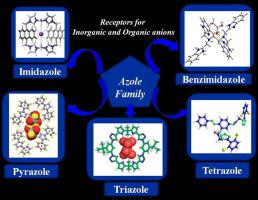Coordination Chemistry Reviews ( IF 20.6 ) Pub Date : 2020-05-07 , DOI: 10.1016/j.ccr.2020.213369 Sujata Kashyap , Rajesh Singh , Udai P. Singh

|
Anion sensing is one of the most important aspects of chemistry and interest towards anion sensing, directly or indirectly, is evident from publications of the last two decades. Anion sensing is an induced response in a receptor in terms of an optical change (color change, UV–Vis and fluorescence) or an electrochemical change due to the recognition of one or more anions. A variety of ligands, including amides, urea, crown ethers etc., have been utilized from time to time as a sensor for both cations and anions. Simple azoles as well as azoles bearing organic molecules exhibit great potential for anion sensing and have been widely used for the sensing of inorganic and organic anions. This review is focused on various azole members (imidazole, pyrazole, triazole, tetrazole and benzimidazol) and has classified them into groups for the recognition of inorganic and organic anions, and also the recognition of ions by their respective metal complexes.
中文翻译:

唑族成员对无机和有机阴离子的感测
阴离子感测是化学领域最重要的方面之一,对阴离子感测的兴趣直接或间接地体现在最近二十年的出版物中。阴离子感测是由于识别一种或多种阴离子而在光学变化(颜色变化,UV-Vis和荧光)或电化学变化方面在受体中引起的感应响应。各种配体(包括酰胺,尿素,冠醚等)已不时用作阳离子和阴离子的传感器。简单的吡咯以及带有有机分子的吡咯具有很大的阴离子感测潜力,并已广泛用于无机和有机阴离子的感测。这篇评论的重点是各种唑成员(咪唑,吡唑,三唑,



























 京公网安备 11010802027423号
京公网安备 11010802027423号